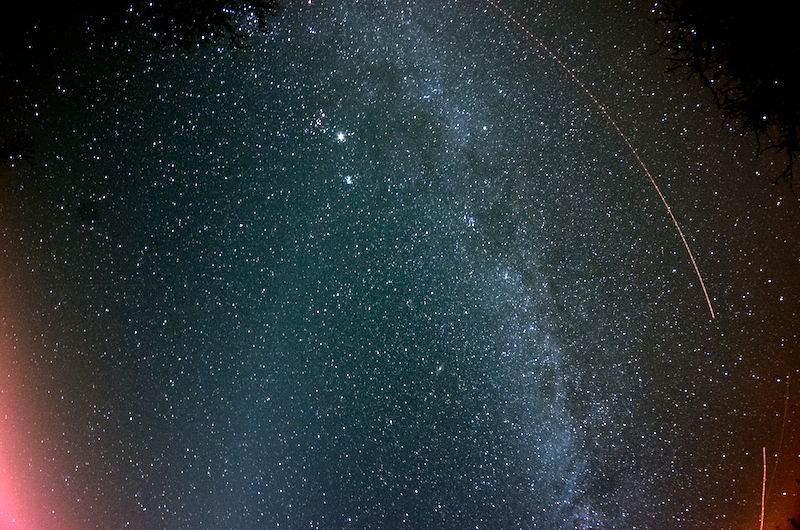
8mm 180° Fisheye Lens Sky Tests
Posted: 5 January 2013
The observatory was opened Friday, 4 January, at 1857 MST, 46°F, to clear skies, with a slight breeze blowing. The goal for the night was to do all-sky imaging tests.
As I discovered during my Geminid Meteor Shower sky photography with the new 8mm 180° fisheye lens, using f/8 (for crisp stars) at ISO 2500, while it worked nicely for the sky, did not capture any meteors. I had been hopeful that the higher ISO would offset being at f/8, but it didn't, at least for meteors. I needed to use a faster aperture or higher ISO setting or both to capture meteors. While watching the Geminids, I saw more airplane lights than were captured in the f/8, ISO 2500, photos. That was the same with the meteors; I saw many meteors but none were captured, even the brighter ones. I decided that airplane trails might be useful as "stand-ins" for meteors for testing purposes.
I set up the LXD55 tripod near the observatory and mounted the D7000 DSLR with fisheye lens on it. While waiting for twilight to end, I did some Jupiter observing with the 8" LX200-ACF at 77X and 222X. At 1819 MST, the four Galilean Moons were visible, as was a star looking like a 5th "moon". The Great Red Spot was just coming into view at the limb. At 1956 MST, viewed Comet C/2012 K5 (LINEAR). At 222X, the head was large and obvious. Using 77X, I could see the comet tail across about half the eyepiece field-of-view, or about 20 arcminutes. I will image this comet on the next session.
I began the sky imaging tests at 1904 MST using f/4, f/5.6, and f/8, at ISO 1600, ISO 3200, and ISO 6400, for 2 and 5 minute exposures. I did the exposures whenever an airplane was visible in the sky. The "Summer Triangle" (the stars Vega, Deneb, and Altair) was visible low in the western sky, with the "Winter Milky Way" running high overhead and down to the southeast. At 1905 MST, I noticed that the Zodiacal Light was visible. As the sky continued to darken, I could see the Zodiacal Light extending almost to the central meridian in the sky. Looking west, the Zodiacal Light and the Milkway made an upright "V" shape of light in the sky. While I was imaging the sky, I would monitor the comet at 77X as it moved against the background stars. By 2120 MST, the breezes had gotten stronger so I parked the telescope. I completed the sky imaging tests at 2134 MST and began closing down for the night.
The observatory was closed at 2157 MST, 38°F.
During post-processing, I studied the 18 images that had been acquired, looking for three things: star sharpness at the edge of the lens field-of-view, sky brightness, and airplane trail visibility. Some coma was visible at the edge with f/4 but was gone at f/5.6. ISO 3200 captured bright airplane trails, with ISO 6400 capturing fainter trails. Using a 2 minute exposure avoided overexposing the sky, whereas a 5 minute exposure tended to be overly bright, obscuring faint trails. This is a f/5.6, ISO 6400, 2 minute exposure:

There are three airplane trails visible at the right, including a faint one at the lower right edge. East is at the top of the image, with south at the left. Orion's belt and sword are at the top edge, left of the Milky Way. Jupiter is the bright object above center, with the Hyades cluster to its left and the Pleiades below it. The Andromeda Galaxy is visible below center, just left of the Milky Way. The Zodiacal Light is the faint glow coming up from the bottom, making an inverted "V" with the Milky Way. Sky glow is in the lower lefthand corner (Tucson and Oro Valley) and lower righthand corner (Casa Grande).
I will do some more sky tests on the next session using f/4.5 and f/5 at ISO 4000 and ISO 5000. I want to determine edge sharpness at those aperture settings. I will also take some Zodiacal Light photographs.
Comments are welcome; use the Comments section below, or you can Email Me. Thanks.
Go to the previous report.
Return to the Cassiopeia Observatory Home Page.